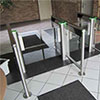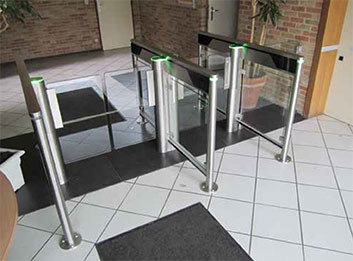
Upgrading Your Entrance Lanes
Taking a layered approach to security in your building
- By Mike McGovern
- Mar 01, 2013
 Is it time to replace or upgrade your pedestrian entrance control (PEC) system? Are your security entrance lanes or turnstiles at end-of-life, and are you starting to consider with what or how to best replace them? If so, then it’s probably time to look at the wide range of competing security entrance lanes/optical turnstiles/portals and examine what features are new, important or critical for compatibility with your available lobby space, your new card/biometric readers and access control systems.
Is it time to replace or upgrade your pedestrian entrance control (PEC) system? Are your security entrance lanes or turnstiles at end-of-life, and are you starting to consider with what or how to best replace them? If so, then it’s probably time to look at the wide range of competing security entrance lanes/optical turnstiles/portals and examine what features are new, important or critical for compatibility with your available lobby space, your new card/biometric readers and access control systems.
Every day, we are seeing an ever-increasing number of requests for new entrance control systems to replace/upgrade/retrofit an older, existing set of turnstiles with new security entrance lanes. End-user clients, along with their security consultants, architects and security integrators are interested in finding the best solution—considering the latest features and technology available.
Pedestrian Entrance Control Systems
The term PECs includes all security entrance lanes, turnstiles/speedgates, barrier-type optical lanes, sliding glass optical portals, high-security portals and security revolvers used as part of an integrated security strategy for an access-controlled building or area within a building. Most entrance control systems are specifically designed to increase security and also enhance the effectiveness of lobby staff, which would otherwise have to check the credentials of every pedestrian passing the secure point.
The PEC works by singling out any pedestrians attempting access without proper credentials. Normally, a card reader or biometric authentication device is built into or integrated with the PEC. The system will usually include technology— infrared or other optical sensors—to detect tailgating and prevent piggybacking, hence the common industry term “security entrance lanes,” also known as optical turnstiles.
Many Systems Reaching End-of-Life
Many commercial and government buildings are now ready to replace pedestrian entrance control and security entrance lane systems purchased 10 to 15 years ago. From 2002 through 2004 there was a sharp increase in the numbers of systems installed, which was greatly impacted by the events of Sept. 11, 2001. Meanwhile, multi-tenant buildings and high-rises in larger cities took advantage of new multitechnology card readers that made front lobby entrance control more realistic. The same factors that make optical lanes and portals attractive for Class A buildings accelerate the products wearing over time, making them appear worn out.
Meanwhile, internal mechanical devices and motors that move the sliding and swinging barriers have long surpassed their life expectancy, even if well maintained. Replacement parts are now becoming harder to find for some models. Downtime is expensive and detrimental to operation and traffic flow, let alone the perceived corporate image associated with non-functional security equipment.
Meanwhile, new state-of-the-art security entrance lanes have been developed, the benefits of which would—financially and practically—support the upgrade or replacement of these old, dated systems.
Product Selection Decisions are Important
Clients have concerns about how to make the right decisions because access control security products like PECs are usually a long-term capital investment. Sometimes there are several levels of decision makers/influencers—end users, consultants, integrators— all of whom have various needs or concerns for the features. Oftentimes on the client’s side, the decision for such systems is a long-term strategic one that requires careful analysis, committee review and upper management action. Another important consideration concerns the existing infrastructure work that was already done onsite.
Clients may want to limit further investments in new conduits, product footprint locations, and the product selection decision can impact the need for such additional costs. Further complicating such decisions is the variety of new physical features, available certifications and software packages that are available.
There are Important Physical Feature Considerations
Physical characteristics, features and overall esthetics of PECs can vary quite a bit when considering dimensional requirements, architectural finishes and lobby design criteria.
The specific client needs and installation site dimensional limitations will play an important role. In the case of replacing and upgrading existing security entrance lanes and turnstiles, the existing footprint versus proposed footprint must be considered. Take into consideration whether you can cover the old floor cuts with the new proposed product, or if you are prepared to renew and re-cut the finished floor. For example, if you are changing from purely optical turnstiles to security entrance lane optical turnstiles with retractable or swing glass barriers, you will need to accommodate new wider/longer cabinet footprint over the existing smaller cabinet/pedestal footprint. Conversely, if the new products will be swinging glass type optical lanes, you will need to ensure that the new slim or shorter cabinet/pedestal fit correctly on the existing wider cabinet spaces. Depending on the circumstances, you may want to consider fitting more lanes than before in the given area. These will be important factors when selecting the new replacement system.
Architectural finishes will be of concern for architects and lobby designers. Many PEC products come in a standard grained stainless finish. But custom colors, solid surfacing, natural wood and stone finishes are usually available as options. Architects like to have choices of custom and natural materials.
Some of the new changes in evolution of the new PECs are that they have sophisticated tailgate and piggyback detection systems, although linear horizontal beams are still most common. The algorithms and firmware today has advanced greatly over the simple PLC systems of 15 years ago, allowing clients to even tailor the sensitivity of their tailgate/piggyback security detection system. Enhanced tailgate/piggyback detection technology improves accuracy, thereby increasing security while reducing cost of false alarms. Of course, today’s PEC security entrance lanes use long life LED lights which years ago replaced incandescent bulbs which had been standard in older turnstiles.
One advancement is network ready, IP addressable security entrance lanes and server-based lane control panels. These advancements open up a wide realm of communication, lane control and maintenance possibilities not available in the legacy analog, dry contacts systems of the past.
Safety and Reliability are Improved
Clients should look at product reliability and MTBF or MCBF data, when available. Some products boast lifetimes exceeding 10,000,000 cycles. This data should be published or readily available with stated testing parameters.
UL-listed PEC and security entrance lanes are more common than ever before. PEC products have been certified in various classifications, and all are very good, with UL 2593 being the new industry standard. Look for PEC systems that carry the UL2593 or UL325—or another certification lab using UL standards— label. Some PECs will only have UL-certified components, but this is not the same as having a UL listed product system with the factory apposed UL sticker, especially in the eyes of many city building inspectors.
Potential buyers will involve others in the research process. It helps to have expert opinions to give support to product decisions when presenting to upper management for budgeting and purchase approval.
We strongly recommend including security consultant/engineers in the process. Their expertise in such decisions is invaluable. There are many excellent firms providing such services. In addition to product selection decisions, they will also provide critical local code knowledge and engineering and product integration design assistance.
Most security integrators have selected, installed, integrated and supported many such PEC systems—they will be able to make recommendations for your specific needs.
This article originally appeared in the March 2013 issue of Security Today.